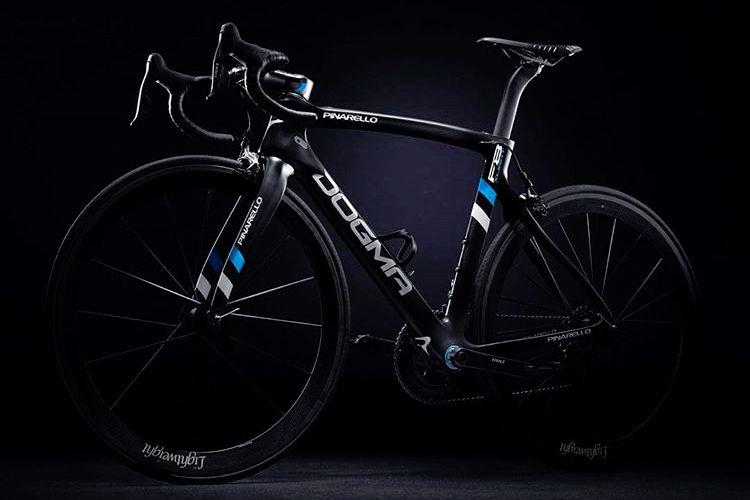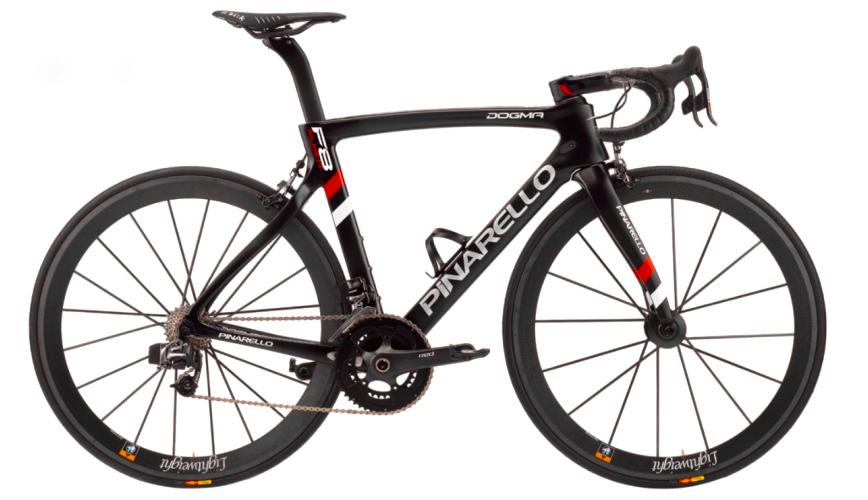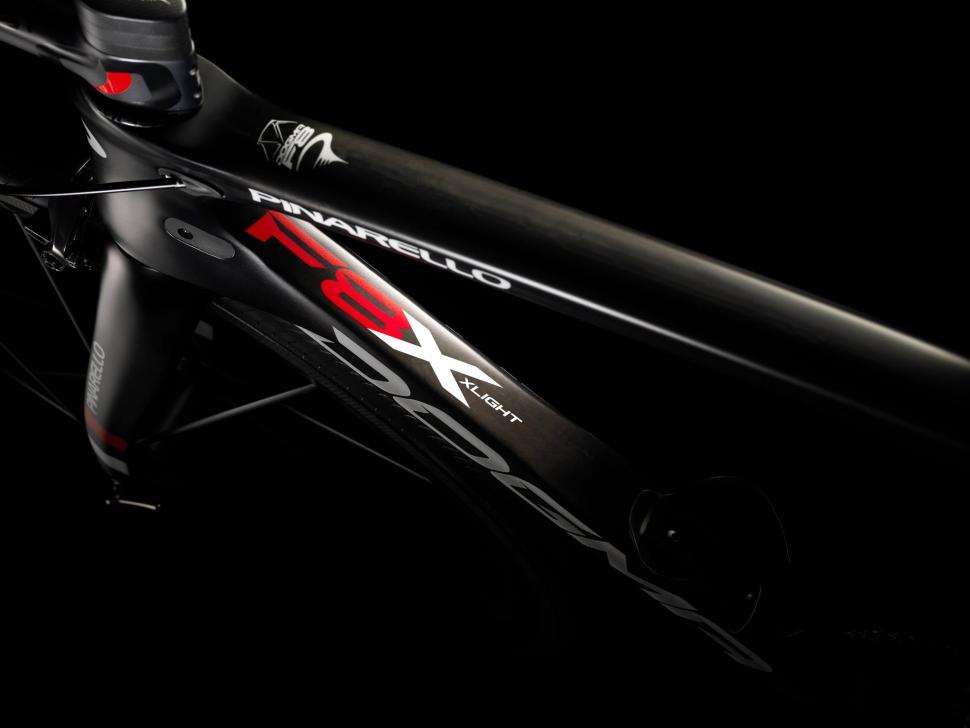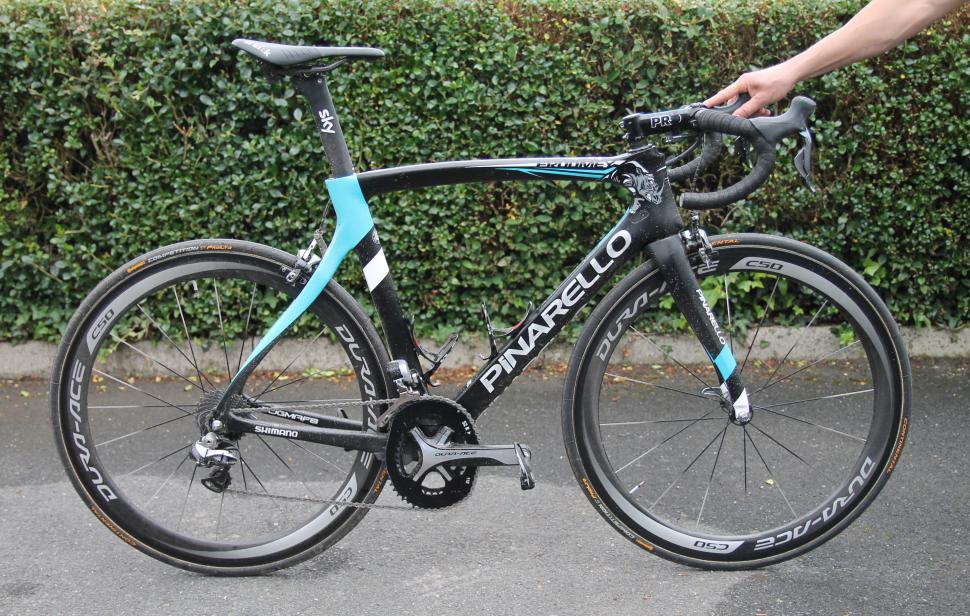- News
- Reviews
- Bikes
- Components
- Bar tape & grips
- Bottom brackets
- Brake & gear cables
- Brake & STI levers
- Brake pads & spares
- Brakes
- Cassettes & freewheels
- Chains
- Chainsets & chainrings
- Derailleurs - front
- Derailleurs - rear
- Forks
- Gear levers & shifters
- Groupsets
- Handlebars & extensions
- Headsets
- Hubs
- Inner tubes
- Pedals
- Quick releases & skewers
- Saddles
- Seatposts
- Stems
- Wheels
- Tyres
- Tubeless valves
- Accessories
- Accessories - misc
- Computer mounts
- Bags
- Bar ends
- Bike bags & cases
- Bottle cages
- Bottles
- Cameras
- Car racks
- Child seats
- Computers
- Glasses
- GPS units
- Helmets
- Lights - front
- Lights - rear
- Lights - sets
- Locks
- Mirrors
- Mudguards
- Racks
- Pumps & CO2 inflators
- Puncture kits
- Reflectives
- Smart watches
- Stands and racks
- Trailers
- Clothing
- Health, fitness and nutrition
- Tools and workshop
- Miscellaneous
- Buyers Guides
- Features
- Forum
- Recommends
- Podcast
TECH NEWS
 pinarello dofma f8x light.jpg
pinarello dofma f8x light.jpgPinarello puts Chris Froome’s Tour de France race bike on a diet. But what's the point?
Pinarello has revealed a lighter version of its Dogma F8 race bike for Chris Froome to do battle in the mountain stages of the Tour de France.
It’s called the Dogma F8X Light and according to the company’s claims, saves about 100g across the frame and fork. The frame, in a size 54cm, weighs a claimed 780g (compared to 860g for a regular F8) while the fork has dropped 20g down to 340g. Pinarello hasn't released a frame weight for the size 56cm that Chris Froome rides, but you can be certain it'll be a fair bit heavier.
The new F8X Light retains the same silhouette as the regular F8 so the weight savings have come primarily from changes you can’t see, under the paint, with a fine-tuning of the carbon fibre layup.
Is there a downside to this new bike? Yes, it comes with a 69.8kg (154lb) rider weight limit. This does seem odd considering brands like Cervelo and Cannondale can produce frames that are lighter than this but carry no rider weight penalties.
Froome is safely inside the weight limit, and he has already been riding this new frame, first with a shakedown in the Criterium du Dauphine and then stage 8 of the Tour de France, which he won in emphatic style on the descent, not on the climb where the new bike might have provided an advantage.
Pinarello will produce just 200 frames for the public in a choice of Team Sky colours, red and black. We don’t have a UK price yet, but in the US it will cost $8,499.
Chris Froome’s bike weighs 6.8kg anyway?
As impressive as Pinarello’s claims for its new lightweight Dogma F8 might be, they seem rather pointless when all bikes in the Tour de France peloton are restricted by the UCI’s 6.8kg minimum weight limit, a regulation that has been in place since the early 2000s.
- Chris Froome's Team Sky Pinarello Dogma F8
According to a Team Sky mechanic we spoke to, Chris Froome’s regular size 56cm Dogma F8 with Dura-Ace C50 wheels is bang on 6.8kg. With the shallower section C35 wheels, it’s a whisker under the weight limit. That’s with a Shimano Dura-Ace Di2 groupset, Stages power meter and PRO aluminium handlebars and stem.
You can bet a team as obsessed with marginal gains as Team Sky famously is would ensure Froome's racing bike is right on the 6.8kg limit, not a gramme over it, and that would count for the regular Dogma F8 as much as the new lighter F8X Light. They don't leave details like this to chance.
Leisurely rest day ride with the team #TDF2016
— Chris Froome (@chrisfroome) July 11, 2016
@vkalut Photo News pic.twitter.com/iNhy9d86fY
And already this Tour we’ve seen Froome mixing up his wheels. He started on the C50 wheels but then switched to a shallower section front wheel for the first mountain stage, and during the rest day training ride he appears to be riding some presumably prototype shallow section wheels from Shimano, pictured in the tweet above.
Given that Froome's size 56cm frame is going to be, at a rough guess, in the region of 30g heavier than the claimed weight for Pinarello's new frame in size 54, it might allow the mechanics can get closer to 6.8kg without going to such efforts to trim away the weight. Froome's current Dogma has some weight saving measures like the stripped back Di2 satellite shifter pod, so maybe the new frame will allow them to get closer to the weight limit more easily.
- Things you only see on pro race bikes
Still, with some lighter wheels fitted, the new bike is going to skirt pretty close to the weight limit. So will the mechanics have to add some weight to the bike to bring the weight back up? Without getting it on the scales and having a good poke around, we just don't know. Adding weight to a lighter frame seems a largely pointless exercise unless the bike was never close to 6.8kg in the first place?
So why would Pinarello be releasing a lighter bike for Chris Froome? Marketing, of course, the Tour de France being a huge shop window to promote products to a world audience.
That 6.8kg weight limit: Pointless, isn’t it?
Why have a weight limit at all? It’s a good question. The rule was introduced to prevent manufacturers pushing the limits when carbon fibre was in its infancy, to protect the racers from riding flimsy and potentially dangerous bikes, and also to provide a level playing field.
- Could the UCI scrap the 6.8kg weight limit in 2016?
That it chose 6.8kg was entirely arbitrary, and it does strike us as a bit strange that the rule hasn’t been regularly addressed as technology in cycling has clearly advanced massively since the rule was first introduced.
It’s very easy to buy a bike that flaunts the UCI’s weight limit. Without resorting to drilling holes in the cranks, you can (provided you’re rich enough) build a bike that weighs as little as 4.6kg in the case of Trek’s Emonda SLR 10, which uses a 690g frame. Merida will sell you the Scultura 9000 Ltd which tickles the scales to the tune of 4.55kg, while AX Lightness have shown a 4.4kg in the past. Focus will even sell you a road bike with disc brakes that is bang on 6.8kg.
- 5 of the lightest road bikes
So should the UCI update or scrap the weight limit? It’s regularly argued and debated and the UCI has made some noises that might suggest it’s prepared to take a closer look at the weight limit, but so far there has been no change.
What do you think? Is it good for the industry or stifling innovation? Do you think the UCI should relax this ruling so we can see just how light some of the Tour de France bikes could be, or would it hand an unfair advantage to the better-funded teams that can afford to have light components and bikes specially developed?
David worked on the road.cc tech team from 2012-2020. Previously he was editor of Bikemagic.com and before that staff writer at RCUK. He's a seasoned cyclist of all disciplines, from road to mountain biking, touring to cyclo-cross, he only wishes he had time to ride them all. He's mildly competitive, though he'll never admit it, and is a frequent road racer but is too lazy to do really well. He currently resides in the Cotswolds, and you can now find him over on his own YouTube channel David Arthur - Just Ride Bikes.
Latest Comments
- brooksby 10 min 39 sec ago
There are comments on the Bristol Post about this along the lines of how pedestrians only ever have to wait a few seconds so why change anything....
- brooksby 12 min 23 sec ago
"A few decades down the line" our civilisation will have likely collapsed… But at least there will be plenty of space to park your Mad Max styled...
- parcours 30 min 53 sec ago
Anything is possible with a custom build. We do a reasonable number of track builds each year & can offer it on any road model in the line-up
- Condor Andy 38 min 8 sec ago
Velogames' Spring Classics comp is open and is more in tune with the road.cc game. You have 24 transfers to use between MSR and LBL. There are also...
- chrisonabike 34 min 27 sec ago
Yup - while I'm normally "more bollards" this needs nuance....
- NPlus1Bikelights 1 hour 10 min ago
Mildly interested. My knees don't like the rotations needed for unclipping, I use well made Japanse MKS half clips on a commuter bike. They do...
- Born_peddling 1 hour 34 min ago
Was just about to say UCI corrupt? Never! 🤣
- Miller 1 hour 34 min ago
Sounds great but worth noting that the Osmo Action 4 can be had for £189 at the moment.
- hawkinspeter 1 hour 36 min ago
Campaigners condemn Liveable Neighbourhood vandalism:...
- Pink Duck 1 hour 50 min ago
The Cyclists Dismount signage is now up, not that anyone pays any attention to it.




Add new comment
12 comments
The 154lb weight limit maybe entirely fictional, they have to sell this bike, albeit in a limited 200 qty, for Froome to use it in the tour.
As other have said lighter frame means they don't have to compromise elsewhere.
What??? Posh bike being pushed up hills? I thought they leapt forward upon every pedal revolution and sprang up inclines??
Coming back to the weight, the best insight on pro bike weights came from the Giro lumpy stage where all the top finishers had their bikes weighed by the officials, and the results show that the pros will often ride slightly heavier bikes providing the weight gives something back, like 40mm rims giving an aero advantage descending or alu bars providing some extra strength, etc:
"Stage winner Esteban Chaves (Orica-GreenEdge) was closest to the limit, with his bike weighing in at 6.870kg. New race leader Steven Kruijswijk (LottoNL-Jumbo) was at 6.900kg, best young rider Bob Jungels (Etixx-Quickstep) came in at 7.00kg, leader of the mountain's classification Damiano Cunego (Nippo Vini Fantini) was at 7.240kg and Sebastian Henao (Team Sky) was a little heavier, with his Pinarello bike weighing 7.320kg."
So no need for any extra weights and the new lighter Dogma will just open up some other kit options that may give Froome a 'free' benefit, albeit marginal.
Power meters built into the cranks, presumably? - Yes
What about pedals? - Yes
Bottle cages? - Yes
Bottles? _ No
Garmin? - No
Garmin mount? - Yes
Tape to mark seat height? - Yes
Second layer of bar tape for the cobbles? - Yes
"This does seem odd considering brands like Cervelo and Cannondale can produce frames that are lighter than this but carry no rider weight penalties"
They designed the bikes from the ground up to be that light with no weight restriction, as opposed to taking an already designed aero frameset that was already as light as they could make it with cabilities at the time and making it lighter with more advanced cabilities but not redesigning it from the ground up.
What is included in the weight limit? Power meters built into the cranks, presumably? What about pedals? Bottle cages? Bottles? Garmin? Garmin mount? Tape to mark seat height? Second layer of bar tape for the cobbles?
I wonder if it's like in F1 where having a below-regulation weight allows you to make up the difference with balast set low in the frame/chassis in order to lower the center of gravity. Probably only a very minor effort for a bicycle...
In fact, in a recent interview a Team Sky mechanic revealed that they prep the bikes 1% (i.e. 60-70g) over-weight to ensure that there is absolutely no chance that they can come in under the limit if they're tested. He cited things like water that is stuck in the frame/wheels coming out over a day's racing, or perhaps a wheel swap for a marginally lighter wheel as a couple of examples that could drop a bike below the weight limit if you're already sitting bang on it.
I think they'll struggle to sell these, I've never seen a non-pro riding an 8 grand Pinarello who wasn't well north of 70kg.
Absolutely spot on!
One of my observations from last weekend's Etape du Tour was that the most likely bike to be seen being pushed up the major climbs was a Dogma F8! (With the pusher draped head to toe in full Rapha kit of course).
Feck.... 70kg weight limit...... that rules out the fat city boys, and they are the only ones who can afford one.
"stage 8 of the Tour de France, which he won in emphatic style on the descent, not on the climb where the new bike might have provided an advantage."
Surely the concept is that he didn't have to expel as much energy getting up the hill in the first place allowing him to feel fresher whilst hammering it down the other side?